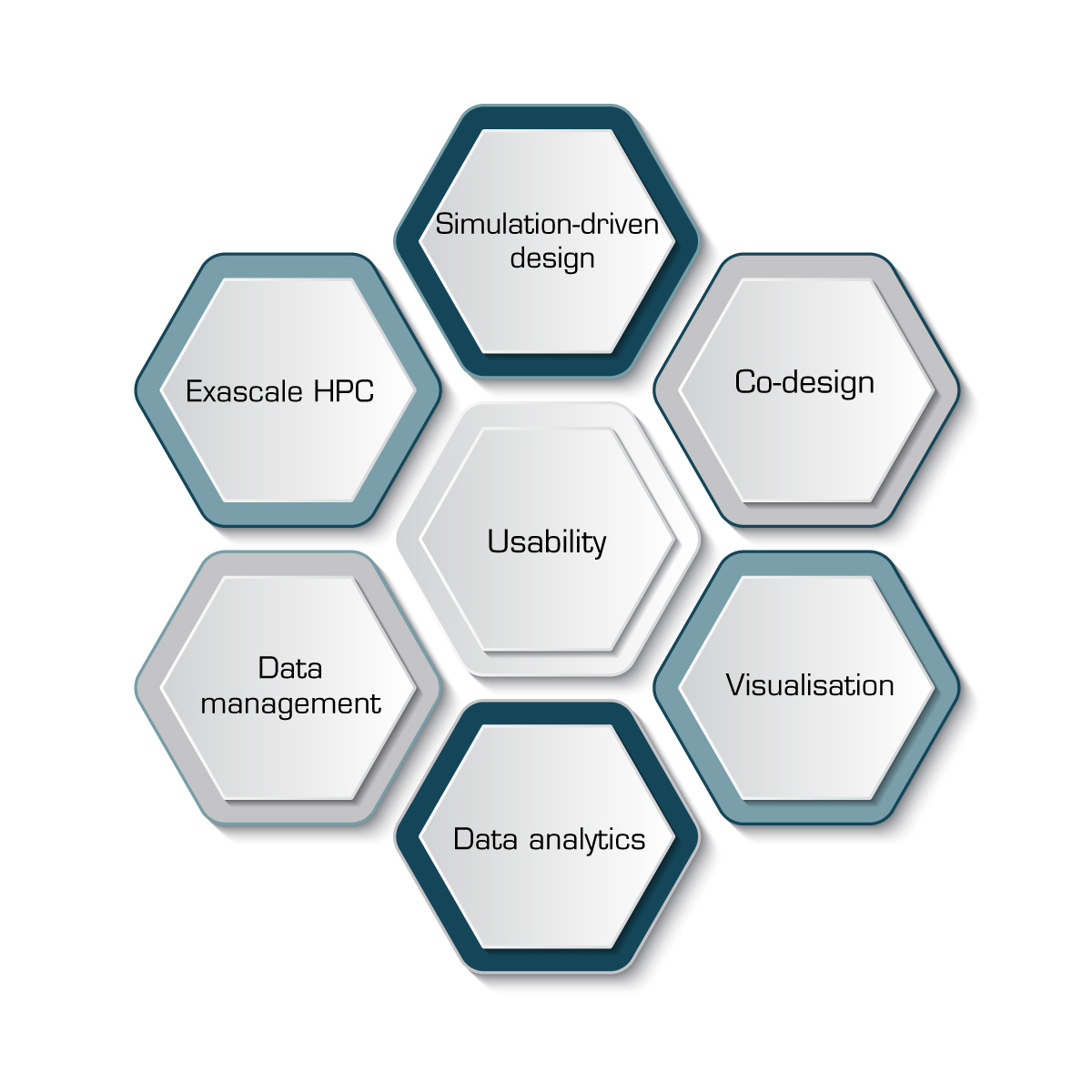Knowledge Hub & Expertise
EXCELLERAT provides knowledge and expertise on how data management, data analytics, visualisation, simulation-driven design and Co-design with high-performance computing (HPC) can benefit engineering, especially in the aeronautics, automotive, energy and manufacturing sectors. EXCELLERAT brings together the necessary European expertise to establish a Centre of Excellence in Engineering with a broad service portfolio, paving the way for the evolution towards Exascale. By Exascale computing, we refer to computing systems that are capable of at least one exaflop, or quintillion calculations per second.
EXCELLERAT is part of the European HPC Strategy realisation, just pushed forward with the activities of the EuroHPC Joint Undertaking.

Exascale HPC
An ongoing effort with leaders in HPC to ensure that codes are optimised on the most advanced computing platforms and to eliminate the computing limitations. Besides, HPC partners develop tools, guidelines and prescribe hardware and system configurations. HPC system owners provide an extensive computational capacity to minimise the long waiting time and wasted productivity that are usually associated with complex systems and computer-aided design (CAD). The partners deliver an integrated suite of services that affords everything required to quickly and easily manage and develop the simulation process until the production ramp-up.
Data management
We develop best practices and provide support for managing the large amount of data produced and used in engineering applications. Our team investigates efficient strategies for pre- and post-processing as well as I/O, storage, accessibility and efficient metadata management. This includes parallel I/O strategies e.g. MPI-IO and parallel file formats, like HDF5 and NetCDF, the exploitation of novel memory and I/O hierarchies, and the development of online data reduction strategies.
Data analytics
We focus on a comparative and advanced analysis of large scale simulation data. Typical tasks are the organisation of the simulations according to the similarity of data fields, e.g. pressure, deformations or the extraction of physical modes in transient simulations. A comparison of simulations on fine meshes with many time steps poses several challenges. Saving all the simulations generates a severe data handling problem. To avoid the data handling, a data analysis after termination of simulations can be performed by extracting some curves, scalar quantities or modes, which implies a drastic reduction in the information content. Therefore, we develop a scalable data analytics client-server infrastructure for an efficient way of performing data analysis for engineering simulations. We implement suitable analysis tools with an interface to the visualisation environment for interactive application. For our reference applications, we implement the technology applied to open industrial use cases that can demonstrate the benefits of the advanced and in-situ data analytics to industrial partners.
Visualisation
In this area, we deal with post-processing, on-line interaction and visualisation of data targeted to Exascale engineering simulations. The challenges lie in the combination of multiphysics applications with complex geometries and highly transient problems resulting in large datasets. Our researchers explore how to handle and analyse such datasets, while identifying user-friendly, efficient and scalable techniques for their visualisation. These techniques help application specialists in gaining insight into the unsteady and three-dimensional content of engineering simulations.
Our expertise lies in the implementation and application of parallel visualisation tools for the analysis of the large data volumes stemming from supercomputing simulations. We develop scalable visualisation workflows, allowing for both interactive and non-interactive in-situ instrumentation. Interactive tools will be implemented for interaction with data and steering of running simulations with both immersive and non-immersive visualisations, libraries for insitu processing will be used and suitable application interfaces will be designed for scalable non-interactive online visualisations of large scale engineering simulations.
Co-design
We are working with Exascale hardware developers (such as Intel, ARM, NVidia, AMD, Seagate, the European processor consortium), especially through initiated interactions within the respective interest groups to take advantage of upcoming trends in software and hardware and match them to code design issues, identified through careful analysis of the codes. We primarily focus on future trends and learn from best practices preparing and supporting initial co-design activities identified through code analysis but also preparing the centres’ co-design capabilities for future user's requirements and implementing them when prioritised.
Simulation-driven design
Usability
We develop best practices and provide support for an engineering simulation's entire life cycle, from pre-processing, including modelling and meshing, execution of simulations to post-processing with scalable visualisation and proper data management.

